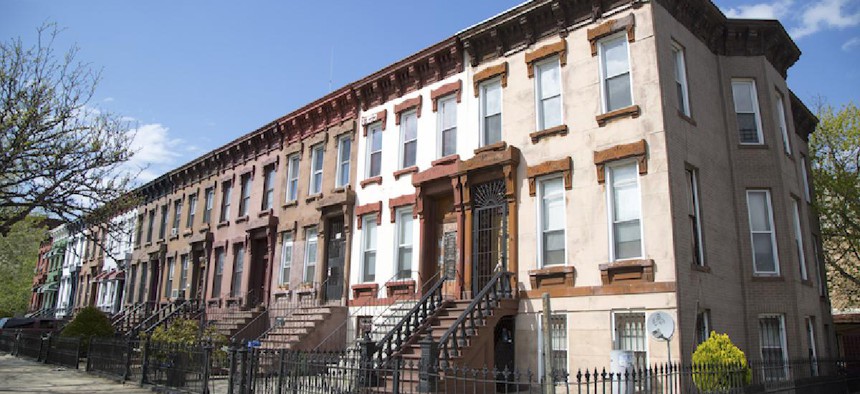For Dr. Brenda Boyd-Bell, a longtime homeowner in Bedford-Stuyvesant, Brooklyn, seeing real estate investors and their agents staked out on her block is nothing new. Historically a predominantly African-American community with a strong tradition of homeownership, home prices in Bed-Stuy have doubled in the last five years, attracting the attention of investors and flippers seeking homeowners willing to sell, especially those who are in financial distress or unaware of the true value of their home.
What did sting, however, was when a particularly bold agent walked up to her door and told her to her face, “You don’t deserve this house. You need to move.”
On other occasions, young people on the block have had to warn speculators targeting elderly neighbors to stay away. And they were right to be concerned: The exploitation of vulnerable seniors in the neighborhood is very real, as detailed in a recent episode of the WNYC podcast “There Goes the Neighborhood,” which highlighted the case of a 90-year old great-grandmother in Bed-Stuy with dementia who apparently sold her home, worth well over $1 million, for $0 to a faceless LLC.
In previous decades, relatively low housing prices meant that Bed-Stuy was a place where middle- and working-class families could afford to own homes. Today, rising property values have outpaced the incomes of most long-time homeowners, as well as renters, who worry that their children will be unable to afford to stay in the community. For struggling homeowners facing overdue tax and water bills, unaffordable mortgage payments, and daunting repair costs to keep their aging homes in livable condition, the affordability squeeze is even more pressing.
Conversations about gentrification often center on its harbingers – the Whole Foods opening up, the yoga studios, the newcomer guilt. But rarely do people talk about the role affordable homeownership plays in stabilizing families, keeping tenants in place, and strengthening communities.
In a recent opinion piece in The New York Times, author and tour guide Michael Henry Adams laments the loss of black cultural identity in Harlem, where rapidly rising property values have led to the displacement of long-time community members as well as many historic cultural institutions and churches. A neighborhood that has served as the cultural capital of black America for more than a century, Harlem’s contributions to shaping the fabric of U.S. history and culture are vast, yet it is being stripped of the very cornerstones that made it the birthplace of modern black literature and an epicenter of jazz.
The piece clearly provoked strong reactions from readers, including hundreds of comments and responses in other publications, and its critique resonated well beyond Harlem and Bed-Stuy. Predominantly Hispanic neighborhoods like Sunset Park and Bushwick in Brooklyn are also experiencing rapid gentrification and face similar concerns about displacement and preservation of cultural identity.
Indeed, throughout the nation, urban neighborhoods that were once havens of affordability for people of color are grappling with changes caused by an influx of investment, and the wealthier – and usually whiter – newcomers that come with it. These changes can be positive, bringing with them new businesses, investments in infrastructure and reduced blight. But these same market pressures can pose a threat to longtime members of the communities they call home, leading to displacement for homeowners and their tenants.
When homeowners are able to afford their mortgage payments, keep up with their bills and make needed repairs, they are able to live, grow and thrive in the city where they have invested their lives, sent their children to schools and pursued their livelihoods. They are able to keep their tenants in place, many of whom pay below-market rents. They are able to continue to contribute to their communities, participate in community institutions, build wealth and provide stable homes for their children.
But homeowner displacement caused by market forces can destroy generations of investment in communities.
Ultimately, affordable, sustainable homeownership is a crucial antidote to displacement caused by gentrification. Fortunately, there are a number of resources available to support homeowners. Through New York Attorney General Eric Schneiderman’s Homeowner Protection Program, attorneys and counselors work with homeowners in foreclosure free of charge, helping them to obtain mortgage modifications that will reduce their payments to affordable levels. The Attorney General’s Office also hosts AGScamHelp.com, which provides tips to homeowners on how to avoid scams and steers them to trusted resources. Several community-based organizations work with homeowners to assemble public and private resources to finance desperately needed repairs. Community-based nonprofits, backed with City Council funding, have ramped up outreach to seniors most at risk of being targeted by speculators and scammers.
But more needs to be done to keep the promise of New York within reach for people of all incomes and all backgrounds. Lawmakers need to back policies that support low- and moderate-income homeowners and create new affordable homeownership opportunities; the city’s tax and water lien sale needs to be overhauled so that it doesn’t burden vulnerable homeowners with exorbitant fees; the purchase of distressed mortgages should lead to principal reductions for underwater homeowners; and city policymakers should prioritize community land trusts, which treat land as a public good that can sustain affordable homeownership.
At the state level, an anti-speculation tax would discourage aggressive property flipping, while providing a more level playing field for families seeking to buy.
While change is inevitable, displacement is not. By supporting existing homeowners and creating new affordable homeownership opportunities, we can ensure the continued existence of vibrant, diverse communities where everyone shares in the economic opportunities of a strong city and state.
Caroline Nagy is the deputy director of policy and research at the Center for NYC Neighborhoods.


